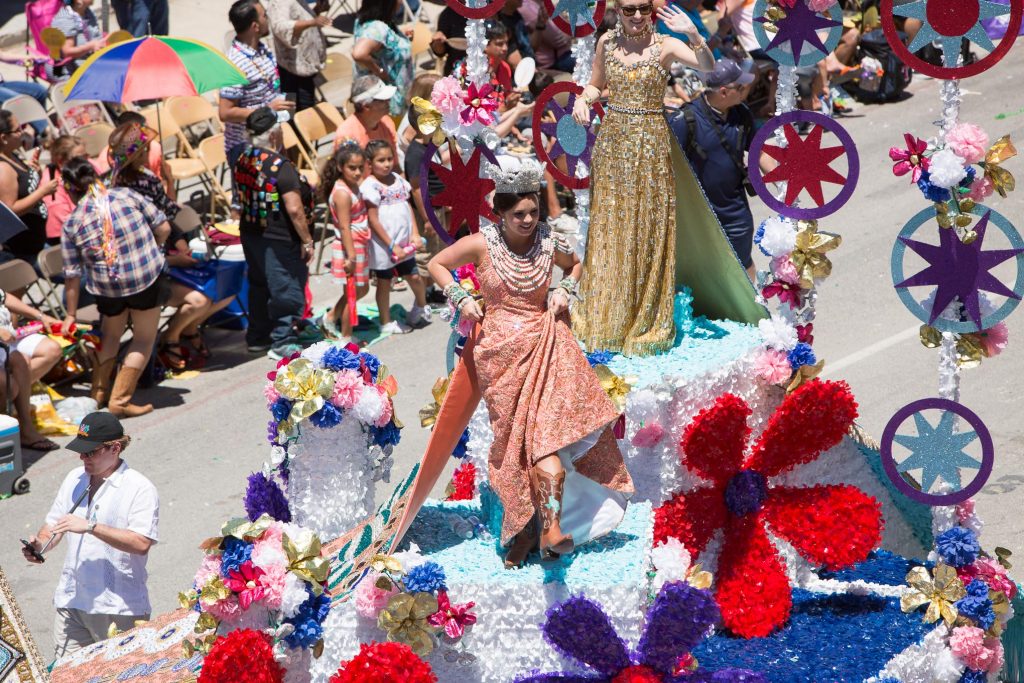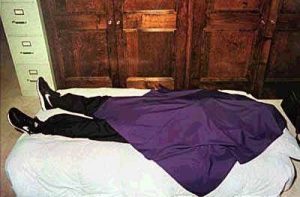Colorful floats; streets closed with barricades; people covering the sidewalks and setting up their lawn chairs to have a good view, having the day off from school; the Marching Bands from High Schools and Universities, decorating their instruments with ribbons, preparing their formation under Highway 37 on Grayson Street; the Fiesta Royalty putting on their best pairs of decorated shoes before stepping onto their throne, mounted on one of the biggest of the parade floats. If you’re a native San Antonian, you know exactly what grand celebration is about occur and what has been going on for the days before; it is part of Fiesta, the ten-day city-wide celebration; it is the Battle of Flowers parade. The Battle of Flowers is a 2.6-mile parade that runs through downtown San Antonio, typically one of the closing events of the Fiesta celebration. This Parades begins on the edge of downtown, and continues onto three major streets: Broadway, Alamo, and Commerce.1 Local schools participate in this parade; their dance troops, mariachi bands, ROTC, and Marching Band programs participate and walk the parade alongside the Texas Cavaliers, the Fiesta Royalty, and the Mayor. Although this annual event has become a hallmark for San Antonians, many don’t know how or when it all began. Let’s go back to its origins, back to the last decade of the nineteenth century in San Antonio.

Originating in 1891, the Battle of Flowers parade was created as a tribute to all those who fought and who fell at the Battles of San Jacinto and the Alamo.2 The idea of a grand celebration to commemorate these heroes came from a tourist, the native-Chicagoan W. J. Ballard. He believed that a proper tribute should be made, and asked a group of local ladies why this had not been the case just yet. His question extended through the city and made its way into newspapers and gained the approval of the community almost instantly. The anticipated idea aroused a spark of interest in Ellen Maury Slayden, a native Virginian elite, who had found her way to San Antonio by marriage to a merchant and later congressman, James L Slayden. Slayden then decided to bring Ballard’s idea to life, and since she knew it was almost impossible on her own, she decided to enlist the help of another newcomer to the area, J. S. Alexander. They both decided to take this on as a pet project of theirs, with the help and support of their husbands. Alexander, a banker before arriving in Texas, provided information on some familiarity he had had overseas about seeing a parade surrounded by flowers, where carts were decorated with flowers. Slayden also remembered similar instances in celebrations she knew about across Mexico and Spain, giving the basis for what the parade would become. The husbands, and many of the elite men of San Antonio, took over the project and had gentlemen speak on behalf of the ladies at the committee meetings; however, as the project grew, the ladies wanted to make sure that it was still a women’s project and continued to provide input and ideas, thus creating the Battle of Flowers Association.3

The parade was originally intended to be an April 21st celebration to celebrate the 55th anniversary of the victory of the Battle of San Jacinto; however, coincidentally, San Antonio was just then expecting its first-ever visit from the White House, the 23rd president of the United States, President Benjamin Harrison. As soon as word got out, the city became ecstatic and prepared a celebration to welcome the President, including moving the parade a day ahead of its original date. With the dates set in stone, the first official planning committee meeting took place only a mere seven days prior to the event. They were frantically trying to gather flowers from nearby towns, since San Antonio had just experienced some heavy rains, which had destroyed most flower gardens, leaving the city with a shortage of flowers just before the parade. Trains were rushed in with shipments of flowers from nearby towns. Other means of making up for the shortage were discussed as well, such as dressing the children up as flowers and having bicyclists decorate their mobiles with whatever blossoms they found and join the parade.4 In the days leading up to the parade, everything seemed all set to go, except for the weather. The city had been plagued with days of heavy rain, and the whole city was hopeful that the rains would cease as the day approached; however, they were wrong. On the morning of the parade, the rains didn’t have mercy on their plans, and as the President’s train arrived, the downpour became continuous. But the rains didn’t stop the city from providing the President with a warm welcome; however, it did postpone the flower parade for the following week, which, of course, would mean that the President would be long gone by then. When the warm weather finally arrived the following week, the parade went as planned; and it was so successful that the committee pushed to have it continue as an annual celebration. It has since been celebrated since 1891, except for the years during World Wars I and II.5

By 1985, the parade continued to grow into the week-long celebration known today as Fiesta. And as the years went by, Kings and Queens were elected as Fiesta Royalty.6 The Parade continues to grow, and so does its recognition across the city and the state. It is now funded by private associations. To this day the parade is one of the closing events of the city-wide, week-long Fiesta party and continues to generate community involvement. Every April, San Antonio puts on a fantastic show, and without a doubt, it all goes back to a Chicagoan tourist, two ladies, and one united community.

- Battle of Flowers, Official Website: Battle of Flowers About us (battleoflfowers.org, 2018). ↵
- Handbook of Texas, June 2010, s.v “Fiesta San Antonio,” by Mrs. Willard E. Simpson, Jr. ↵
- Jack Maguire, A Century of Fiesta in San Antonio (Austin, Texas: Eakin Press, 1990), 13-15. ↵
- Jack Maguire, A Century of Fiesta in San Antonio (Austin, Texas: Eakin Press, 1990), 17. ↵
- Jack Maguire, A Century of Fiesta in San Antonio (Austin, Texas: Eakin Press, 1990), 17; Laura Hernandez-Ehrisman, Inventing the Fiesta City, Heritage and Carnival in San Antonio (New Mexico Press,2008), 21. ↵
- Handbook of Texas, June 2010, s.v. “Fiesta San Antonio,” by Willard E. Simpson, Jr. ↵



117 comments
Suvesh Vasal
I had never heard of this celebration because I am not from San Antonio but I will definitely be attending this year. The culture in San Antonio really unites the city together and I am completely positive that things such as this help 100 x more. Although I am from Dallas, the city of San Antonio is truly inspiring and it is a home away from home. Really interesting article.
Derek Esquivel
Being from San Antonio Fiesta is my most favorite times of the year besides Christmas. It is just a wonderful event that helps benefits the city and is a great way to experience something that you have probably never seen before. But of course, the best part is probably getting the chance to eat all of the different kinds of food you cant go to NIOSA and not get a chicken on the stick.
Kayla Lopez
This was a very fun article to read and really kept my attention due to the fact that this year will be my first time celebrating Fiesta in San Antonio. It was interesting to find out that this celebration came about thanks to W. J. Ballard, who was from Chicago, and him wanting to have a tribute to those who fought and lost their lives at the Battles of San Jacinto and the Alamo.
Anna Guaderrama
I’m not from San Antonio, so it’s nice to see some of the customs that are popular here. Personally, from reading this article, I loved the first sentence in your introduction and how you incorporated some history into such a trendy event. Aside from just being a parade I found it very interesting to read about its historical aspects and significance. I look forward to hopefully attending and seeing what San Antonio has to offer.
Rafael Lopez-Rodriguez
Every time Fiesta time arrives here in San Antonio I learn so much about the rich culture of this city. Since I first arrived here in Texas I had no idea about these type of festivities. I am yet to attend a battle of the flowers event but I would love to go to one. Good job on the article telling the history of this rich cultural event that represents every single one that identifies with the city!
Max Lerma
It was great to see an article on this parade. I am a San Antonio native and this is such a large part of the what the city represents. It also is a testament to the ability for people to unite and celebrate together. As I stated, being from San Antonio, I am probably a little biased towards this parade, but I am glad you took the time to write about it and share its origin story and its meaning with the readers of this website.
Maria Mancha
San Antonio has so much rich culture to it. I myself have sadly never attended the battle of flowers parade but my whole life I’ve always seen the floats on tv and learned about the history in class. I just wish you wouldve one over the “Show me your shoes” it wouldve been nice to know a little history. However besides that it was such a great article I think you captured the San Antonion Pride and culture that we have. I love San Antonio its where I was born and raised. So especially with fiesta coming up I think this article was perfect to read.
Jason Garcia
Every year I would have a break in celebration of The Battle of Flowers but I never understood the significance of the data or the history behind the holiday. This article does a perfect job of blending the past and the present while giving historical insight into a San Antonio tradition that a deep and meaningful connection to the people and the place we call home
Ana Gonzalez
I have lived in San Antonio for two years now, but have never known the true meaning or the reason behind the Fiesta celebrations, including the Battle of the Flowers parade, began. They are beautiful events that encourage the entire community and residents of San Antonio to participate and celebrate the history behind the city. I enjoyed the article and learning more about the way San Antonio honors the events that have taken place in the city year after year. I really like the picture that depicts the women in the car decorated with flowers, good job!
Kimberly Simmons
The Battle of the Flowers Parade is one with great history! One can’t simply live in San Antonio and not know of its history; this article does a very nice job of providing just that. I have lived in San Antonio my whole life and never knew that it was created at a tribute to those who fell at the Alamo. I appreciate this article and its message, very well done!